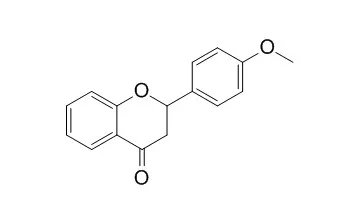| Structure Identification: |
| Analytica Chimica Acta, 2012,738(13):85--94. | | Evaluation of novel amylose and cellulose-based chiral stationary phases for the stereoisomer separation of flavanones by means of nano-liquid chromatography.[Reference: WebLink] | Three polysaccharide-based chiral stationary phases, Sepapak® 1, Sepapak® 2 and Sepapak® 3 have been evaluated in the present work for the stereoisomer separation of a group of 12 flavonoids including flavanones (flavanone, 4'-Methoxyflavanone, 6-methoxyflavanone, 7-methoxyflavanone, 2′-hydroxyflavanone, 4′-hydroxyflavanone, 6-hydroxyflavanone, 7-hydroxyflavanone, hesperetin, naringenin) and flavanone glycosides (hesperidin, naringin) by nano-liquid chromatography (nano-LC).
METHODS AND RESULTS:
The behaviour of these chiral stationary phases (CSPs) towards the selected compounds was studied in capillary columns (100 μm internal diameter (i.d.)) packed with the above mentioned CSPs using polar organic, reversed and normal elution modes. The influence of nature and composition of the mobile phase in terms of concentration and type of organic modifier, buffer type and water content (reversed phase elution mode) on the enantioresolution (Rs), retention factor (k) and enantioselectivity (α) was evaluated. Sepapak® 3 showed the best chromatographic results in terms of enantioresolution, enantioselectivity and short analysis time, employing a polar organic phase mode. A mixture of methanol/isopropanol (20/80, v/v) as mobile phase enabled the chiral separation of eight flavanones with enantioresolution factor (Rs) in the range 1.15–4.18. The same analytes were also resolved employing reversed and normal phase modes with mixtures of methanol/water and hexane/ethanol at different ratios as mobile phases, respectively. Loss in resolution for some compounds, broaden peaks and longer analysis times were observed with these last two chromatographic elution modes. |
|






 Cell. 2018 Jan 11;172(1-2):249-261.e12. doi: 10.1016/j.cell.2017.12.019.IF=36.216(2019)
Cell. 2018 Jan 11;172(1-2):249-261.e12. doi: 10.1016/j.cell.2017.12.019.IF=36.216(2019) Cell Metab. 2020 Mar 3;31(3):534-548.e5. doi: 10.1016/j.cmet.2020.01.002.IF=22.415(2019)
Cell Metab. 2020 Mar 3;31(3):534-548.e5. doi: 10.1016/j.cmet.2020.01.002.IF=22.415(2019) Mol Cell. 2017 Nov 16;68(4):673-685.e6. doi: 10.1016/j.molcel.2017.10.022.IF=14.548(2019)
Mol Cell. 2017 Nov 16;68(4):673-685.e6. doi: 10.1016/j.molcel.2017.10.022.IF=14.548(2019)